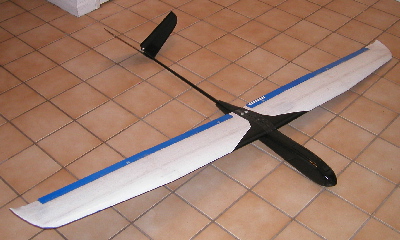



























**NEW UPDATE!... be sure to scroll down the page to see the major pod/boom re-design!
OK, the Orange Un-Crushable (proto #1) went extremely well. Now I will take what I learned from that project and apply it to this one.
OBJECTIVE: A durable high performance thermal/slope and some what all around "full house" ship (aileron, flaps, elevator, rudder) that I am not afraid to launch in the sketchiest of conditions or worst of flying sites. I want something that I can bang around, yet still have a good performance envelope. This will be similar to #1 prototype, but with a higher aspect ratio wing and the added flaps of course.
This is my 2nd EPP proto ship, however I did again use a wing kit this time a little higher aspect ratio wing from a Highlander 2 Meter foamie ship from Mad Aircraft Designs. I modified this wing in a few ways: First I made it two piece and secondly I modified the wingtip area. I also added a full length carbon strip along the spars.
I again wanted to use Coroplast for the tail feathers even though it weighs a little more. The Tail on my #1 plane worked very well, so this one is nearly the same design, only a little better construction and lighter weight.
I am using a similar pod and boom design to minimize weight and ease replacement/modification of the over all length. I found a slightly lighter tapered boom to use this time. My goal is to keep it under 35 oz.
Click on the thumbnails to ENLARGE.
WHAT I'VE LEARNED: Well I tried to save a little weight by making the boom shorter even with the longer wing. It still flys GREAT but I needed to couple a bit of rudder with the ailerons and dial in a lot of differential to get it to track nicely. Once that was done this ship flys great!
It will fly SLOW it will fly fairly FAST and most importantly it BOUNCES! Several cartwheels later the worst damage has been a broken rudder spar tube. Fixed that in 5 minutes.
Once in a turn it is really neutral needing very little input to keep it going where you want. It thermals in light lift and slopes pretty well even without ballest.
WHAT WOULD CHANGE? Well I had an early on mishap on a wing in a dive test (ok I broke it!) so I would beef up the spar on the next one if I wanted to do radical high speed stuff. Also I am not sure this wing is any better than the DAW 1-26 wing from proto #1 as far as flight charactaristics goes, so I will probably go back to that wing. I also have some other booms coming from TailBoom.com that should help reduce the tail weight without sacraficing any strength.
**UPDATE!
Well, as a thermal flyer this plane was great, but as a speed demon it had a few flaws that caused its premature destruction.... I did fly it all summer with these known flaws... then I pushed the limits a bit too much! Here is the story... and lessons learned:
I was flying inverted and basically screwing around and then I did a screaming power dive. At near trminal velocity I pulled up.... nothing... pulled up MORE... still NOTHING. I fumbled for the crow mix switch to slow things down, but too late it plowed into the ground at full speed from about 200 + feet.
I had changed out my original boom for a really light weight (and flexy) DLG boom to try to reduce the tail weight. The push rods were light and flexy as well and the nose pod area flexed a little too. All around too much flex and under great speed it turned out that it would not pull out of the dive - VERY BAD! In retrospect of that flight I should have just tucked it under, gone inverted again and slowed it down then re-gained control. OH WELL!
Actually as far as the structure itself I only broke the boom and a wing spar - both EZ to fix, however more expensively I mashed the battery and Rx too. I could have easily rebuilt it but I opted for an all new pod and boom of better construction and design.
The new design is about as stiff as a glass ship! I also made the ruddervators PULL to bring the nose up instead of pushing so no more chance of of flexing push rods in a dive. I also went with an Allegro boom from tailbooms.com which only weighed about 10 more grams but is super stiff. The final thing I did that made the pod area SUPER STIFF was to insert 5 lengths of flat 1/32 x 1/4" carbon fiber strips throughout the pod/fuse area.
Here are a few photos of the new pod/boom design. This thing flys great! It will slope, thermal, hi-start... and BOUNCE! This plane now goes with me every time I fly!
Well, that is about it. The plane flyes great and is lots of fun since you can fly with no fear of damaging it! It was a lot of work designing, re-designing etc, but well worth the effort!
Here is the new configuration all finished up.

|